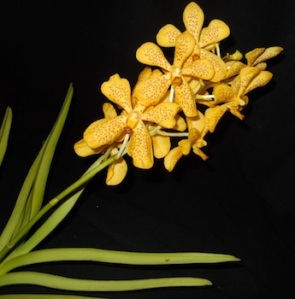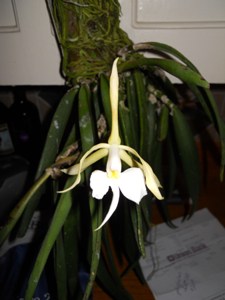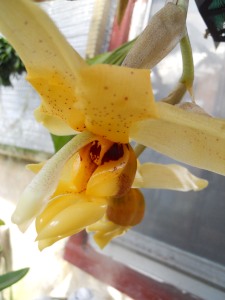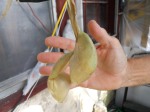After more than a year hiatus, I’ll restart the Orchids Alive in Zone 5 blog with a few photos of the a few of the orchids in the collection that are blooming. See the Photos page for more images. The three orchids – Mokara Salaya Gold; Brassavola nodosa; and Phal. Be Tris. All are reliable bloomers. The Brassavola and Phal. often bloom more than once a year. This time, however, Br. Nodoa produced 41 blossoms, a record for this plant, which I bought at a nursery in Corpus Christi, TX, in 2002. The Mokara was bought six years ago at the neighborhood HyVee.
Blogging and weekly orchid inspections took a backseat to a little summer R&R during the last couple of weeks. The only visible damage to the collection that I can find so far is a cattleya once hung in the apple tree was blown to ground, pot broken and bark scattered. The orchid itself, C. Chocolate Drop ‘NOK’, is a vigorous plant with several still-intact sheaths. Continue Reading »
Posted in Care, Environment, Plants and flowers | 1 Comment »
Over the weekend, one of the several seedlings bloomed that I bought a couple of years ago during Tom and Barbara Larkin’s annual Whippoorwill sale in Arkansas. [See last week’s post about another plant I bought at the sale.]
It is a Larkin cross between Pot. Hoku Gem ‘Sun Spots’ x Pot. Little Toshie ‘Gold Country’, AM. When I bought it, I hoped for a mini catt with spotted flowers. Continue Reading »
Posted in Plants and flowers | 2 Comments »
The orchids, especially the Catts, are budding up and blooming. Since leaving the greenhouse this spring, they’ve shed the doldrums of confinement and become lush and vigorous – well, at least most of them have. Even the ones that aren’t actually in bloom have developed numerous sheaths, harbingers of beauty for the fall and winter.
Several of the current bloomers are pictured on the Photos page:
Cattleya maxima is a particular favorite. I bought it several years ago on the final day of the OSGKC show when the vendors were breaking down their booths. A desiccated, bare-root C. maxima had been tossed in a heap with some other plants by the Ecuagenera salesman. The plant had a withered flower so I was hopeful that, despite my lack of experience with bare-root purchases, this plant was a viable bloomer – which it has been, every year since I bought it. I grow it in a shallow, clay pot with a medium bark, charcoal and inorganic pellets mix
The Catasetum ochraceum is also a reliable and fragrant bloomer. This year it produced a record number (for me) of inflorescences . In addition this is the first year that I’ve had a female flower on this multi-sex plant. (That’s the flower pictured on the Photos page.] Continue Reading »
Posted in Care, Culture, Environment, Plants and flowers | Tagged Brassia, Catasetum, Cattleya, Greenhouse, Laelia, Miltassia, Vanda | Leave a Comment »
More than 15 years ago, I bought a little time-saving device for fertilizing my flower and water garden. At some point, I stopped using it. I don’t know why. Probably laziness.
 At any rate, last winter I noticed that, as the number of orchids in my collection grew, the time I spent trying to feed, clothe and discipline them was also growing – and growing and growing. Most weekends, I would spend an entire day toiling over each plant – fertilizing, watering, examining, staking, repotting (occasionally), pruning and repositioning for optimal light/temp/moisture/breeze conditions.
At any rate, last winter I noticed that, as the number of orchids in my collection grew, the time I spent trying to feed, clothe and discipline them was also growing – and growing and growing. Most weekends, I would spend an entire day toiling over each plant – fertilizing, watering, examining, staking, repotting (occasionally), pruning and repositioning for optimal light/temp/moisture/breeze conditions.
Hard to have a life when 50% — or more — of your time off is spent as a slave to orchids.
Now don’t get me wrong. I adore futzing with my orchids. But I also adore doing other things – or I might, if I had time.
What I needed was some serious time management assessment…And then I remembered that little siphon. Continue Reading »
Posted in Care, Fertilizing orchids | Leave a Comment »
Epi. parkinsonianum — aka Epi. Once-in-a-Blue-Moon — has condescended to bloom again. The last time it sent out its creamy and white blossom, with a texture almost as dense as a hoya flower, was a little more than two years ago.
Not sure what the trick is. Last winter was relentlessly cold. Although the Escabe furnace fought the brave fight keeping the greenhouse’s temperature up, the thermostat sometimes dipped down into the upper 40s at night. Was that the trick? I always position the long, thick-leafed Epi. up high for maximum exposure to light, and I mist it every morning, as I do all the mounted plants. Was that the trick?
Who knows.
Since early May the plant has lived outside in the summer house, again hanging high up for optimum brightness. This year, summer heat came early to our midwest strip of Zone 5. Even back in late June, the temperatures sometimes remained in the 90s for several days. By July, the 90s became common — occasionally hitting 100. Lately, the heat index often goes above 100.
Was that the trick?
Posted in Care, Culture, Environment, Plants and flowers | 2 Comments »
This summer, we’ve been renovating the greenhouse.
- Extra shelving was added in early June.
- Last winter the large, framed hardware cloth used to hang many of the mounted orchids had partly broken loose from the wall. We reattached it.
- The legs on one of the benches had begun to sag. They were rebuilt and reinforced.
And then we tackled the walls…
Posted in Environment | Leave a Comment »
Some folks tell me that a Stanhopea bud pops like a little firecracker on the Fourth of July when it opens. I missed the pop, but on Friday morning I discovered that my long awaited Stanhopea florida had at last opened!
It’s two blooms were a creamy, pale yellow accented with white and red spots. The larger flower was 5 1/2 inches across; the second was a 1/4 inch smaller. The blooms lasted three and a half days.
While its longevity is brief, the fact that it bloomed at all has renewed my hope and confidence that I might be able to encourage blooms from other plants in my collection in that wonderful, pendulous genus.
Posted in Uncategorized | 3 Comments »
My little Phal. equestris ‘Riverbend’ is blooming. It’s a young plant, just one inflorescence rather than the multi-inflorescences that I’ve seen on older
Riverbends…but oh my, this little orchid is a workhorse . It blooms two or three times a year. A couple of years ago, I had another equestris, which was pest and disease prone. Not so ‘Riverbend.” This equestris has an iron-tough constitution. If you’re looking for a little Phal and the colors of this one appeal to you, contact Tom Larkin at Whippoorwill Orchids. Tom is the breeder: 9720 Larkin Lane Rogers, Arkansas 72756. Phone: (501) 925-1885. Fax: (501)925-2428.
Posted in Plants and flowers | Leave a Comment »
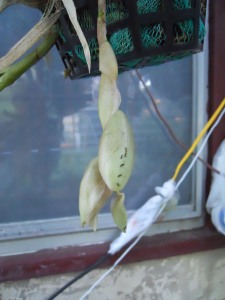 This week’s blog posting is delayed while I wait for the final unfurling of the long-awaited Stanhopea florida blossoms. Photo shows progress –excruciatingly slow progress — of its unfurling. [Note ants — those ubiquitous ants!]
This week’s blog posting is delayed while I wait for the final unfurling of the long-awaited Stanhopea florida blossoms. Photo shows progress –excruciatingly slow progress — of its unfurling. [Note ants — those ubiquitous ants!]
Posted in Uncategorized | 2 Comments »
